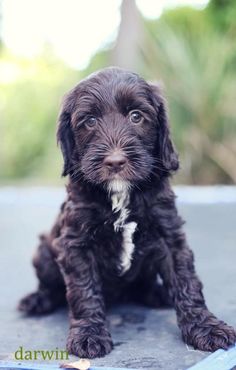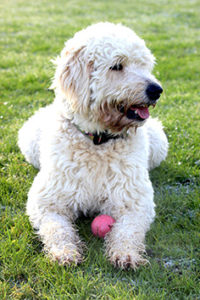
Why a Labradoodle?
History and Types of Labradoodle
 Labradoodles, also known as "Labrapoodles," first occurred in 1955, but they did not gain popularity until 1988, when the mix began to be used as a hypoallergenic guide dog.
Labradoodles, also known as "Labrapoodles," first occurred in 1955, but they did not gain popularity until 1988, when the mix began to be used as a hypoallergenic guide dog.
Currently, they are not considered a breed by any major fancier and breeder organization. Not all Labradoodles are hypoallergenic. Generally, F1 Doodles—which are a 50/50 mix of Poodle and Labrador—are not hypoallergenic. However, this is greatly determined by the fullness of the dogs coat. The thicker and fuller the coat, the less likely the dog will be to shed, along with having less dander.
Labradoodles comes in three distinct versions. There is the F1—which is a 50% Poodle and a 50% Labrador. These dogs may or may not shed and if they have a fuller, thicker coat, they will most likely have less allergy issues than a Labrador. The second classification of Labradoodle is the F1B—The F1B is an F1 bred back to a poodle. This will result in a roughly 75% Poodle & 25% Labrador. F1B's can have a wavy or curly coat & are generally hypoallergenic and non-shedding if they have a curly coat. The third generation is an F2. An F2 is a F1B bred back to a Poodle. You now have a roughly 85% Poodle & 25% Labrador. F2's are hypoallergenic and non-shedding.
Austrailian Labradoodles- A fancy way of saying the dog is mixed with cocker spaniel or mini poodle, along with standard poodle and Labrador.
Appearance and Temperament

The Labradoodle is crossbred between a Labrador Retriever and a poodle. All Labradoodles- F1, F1B or F2 are friendly, very social, great with adults & children, enjoy the water, extremely intelligent- the Poodle is rated the second most intelligent dog next to the Border Collie- very loving & playful. Energy levels will range from medium/high- F1 to medium- F1B, to medium low- F2.
Straight-coated Labradoodles are said to have "hair" coats, wavy-coated dogs are said to have "fleece" coats, and curly-coated dogs have "wool" coats, like a poodle.
